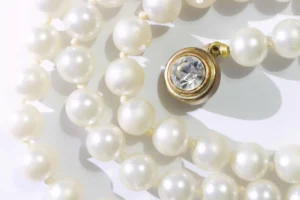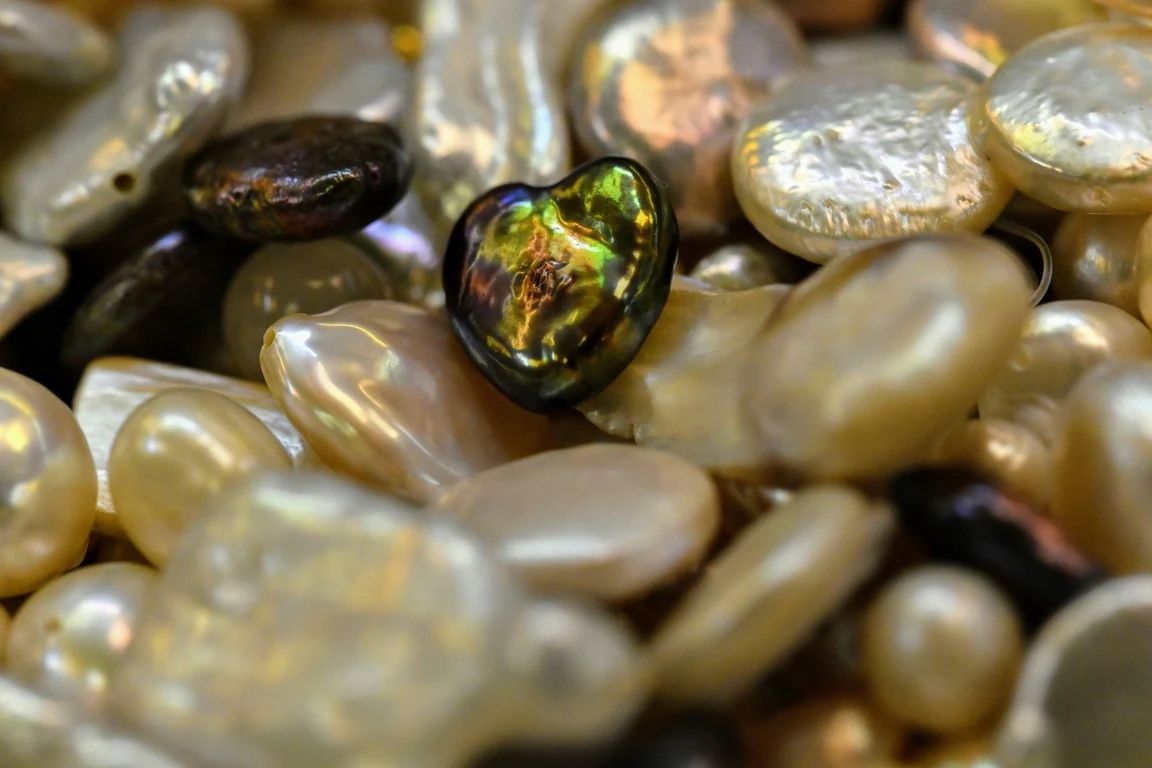Pearls stand out in the gem world as the only jewels born from the heart of living creatures. These shimmering beauties are crafted layer by layer with calcium carbonate, right inside mollusks. Imagine a tiny unwanted guest, like a speck of sand or a small parasite, getting cozy in a mollusk. This little intruder kick-starts the creation of a pearl. The mollusk, in its quest to protect itself, wraps the irritant in nacre, a glossy and robust substance, crafting a pearl as its natural defense mechanism.
That is why today’s blog topic on JewelryBro will be about pearls, or more precisely, different types of pearls.
Properties and Characteristics of Pearls
What makes a pearl truly striking? It’s all about the luster, color, size, surface, and shape. The luster, that gentle inner light, and sheen on the surface, is what catches your eye first.
There are different types of pearls, and they also come in different colors, both in their natural form and in the form of modern cultivated marvels. The palette most are acquainted with includes the classic white and cream, a subtle shade akin to light yellowish brown. Beyond these, black, gray, and silver hues are not uncommon, yet the spectrum of pearl colors stretches across every conceivable hue. The primary color, or body color, of a pearl, often plays host to secondary hues known as overtones, which beautifully modify the pearl’s appearance. These overtones can range from pink (occasionally referred to as rosé) to green, purple, or blue, adding depth and complexity to the pearl’s allure. Moreover, some pearls exhibit an iridescent quality known as orient, adding a magical shimmer that enhances their natural beauty.
And while the globe treasures those perfect spheres, pearls come in an array of shapes:
- Semi-Baroque: This category includes any pearl that is slightly irregular in shape, including off-round, drop, and button shapes that do not fit into the traditional categories.
- Baroque: Characterized by their irregular, non-spherical shapes, baroque pearls are unique and varied. Their distinctive forms are prized for adding an artistic or avant-garde touch to jewelry.
- Teardrop: Also known as drop pearls, these have a rounded end that narrows to a point. They are particularly favored for pendants and earrings, where their graceful shape can be showcased.
- Oval: Longer than they are wide, oval pearls have an elegant shape that works beautifully in necklaces and bracelets, offering a slightly more unique look than round pearls.
- Near-Round: These pearls are almost round but may have a slight irregularity in shape when viewed closely. They offer a similar appeal to perfectly round pearls but often at a more accessible price point.
- Round: The most sought-after and classic pearl shape, perfectly spherical pearls are highly valued for their symmetry and traditional beauty. They are ideal for elegant and timeless pieces, such as stud earrings and single pearl necklaces.

Pearl Luster & Shapes
Natural Pearls vs. Cultured Pearls
On one hand, you’ve got the natural pearls—those serendipitous gifts from the deep. These are the pearls that carry stories whispered through the currents of the Persian Gulf, each one a testament to an age-old allure that’s woven into the very fabric of nature.
Turn the page, and you enter the domain of cultured pearls. In today’s pearl farms, the majority of mollusks are carefully bred for the sole purpose of pearl production, although the tradition of using wild mollusks persists. The journey of a cultured pearl begins with the gentle hands of a technician, who delicately places a piece of the donor mollusk’s mantle tissue, sometimes accompanied by a shell bead, into the receiving mollusk. This intricate procedure can occur in the gonad with a bead to start a pearl or directly into the mantle for a beadless creation. Over time, the mantle tissue nurtures this implant, secreting layers of nacre that eventually crystallize into the lustrous orb we know as a cultured pearl. This meticulous process is overseen by dedicated workers, ensuring each pearl reaches its full, gleaming potential before being gently harvested.
Natural pearls stand as the hidden jewels of the ocean, elusive and forever in demand for their pristine charm. Cultured pearls, meanwhile, democratize this beauty, bringing the ocean’s marvel to more admirers through deliberate and thoughtful craftsmanship.
Different Types of Cultured Pearls
Diving into the world of cultured pearls, each type beams with its charm and story. Here’s the essence, wrapped in the style you favored.
Akoya Cultured Pearls
Hailing from the shores of Japan and China, Akoya pearls are the quintessence of pearl elegance. Picture the kind of pearls that scream classic beauty – that’s Akoya for you. Renowned for their mesmerizing roundness and the kind of sheen that catches the eye, these pearls are the definition of timeless grace. They’re the ones you reach for when you want that touch of sophistication, often found gracing necklaces with a hint of pink glow.
South Sea Cultured Pearls
Imagine pearls floating in the sunny waters of Australia, Indonesia, and the Philippines – these are the pearls of the South Seas. These are not just any pearls, they are big players known for their impressive size and a luster that seems to emanate from dreams. They shimmer in shades from pure white to deep gold, creating an image of opulence, bold, and undeniably luxurious.
Tahitian Cultured Pearls
Now, take a journey to the lagoons of French Polynesia where Tahitian pearls lurk, cloaked in mystery. These aren’t your everyday pearls; they boast colors that tell tales of the deep sea, from metallic silver to peacock green. They’re the pearls that don’t whisper but shout, perfect for those moments when you want your style to speak volumes.
Freshwater Cultured Pearls
Last but not least, venture into the vast landscapes of China where freshwater pearls thrive. Here lies diversity like no other – in form, size, and hue, these pearls redefine versatility. Pastel shades and a myriad of shapes make them the wild card of the pearl world. Mostly composed of nacre, they glow with a soft luster that’s all their own, making them a go-to for jewelry that’s as unique as the person wearing it.

Each different type of pearl brings its unique charm and beauty, catering to different tastes and preferences. Whether you’re drawn to the classic elegance of Akoya pearls, the bold luxury of South Sea pearls, the exotic allure of Tahitian pearls, or the versatile charm of freshwater pearls, there’s a type of pearl out there for everyone. Pearls continue to captivate with their timeless beauty, proving that this classic gemstone can suit any era or fashion. Just dive in, explore, and let these organic gems reflect your style and story.

